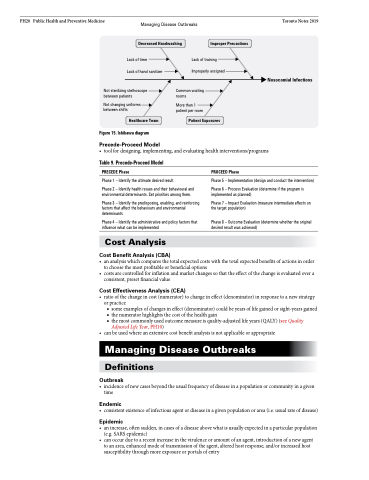Page 1238 - TNFlipTest
P. 1238
PH20 Public Health and Preventive Medicine Managing Disease Outbreaks Toronto Notes 2019
Decreased Handwashing
Lack of time
Lack of hand sanitizer
Not sterilizing stethoscope between patients
Not changing uniforms between shifts
Healthcare Team
Figure 15. Ishikawa diagram
Precede-Proceed Model
Improper Precautions
Lack of training Improperly assigned
Common waiting rooms
More than 1 patient per room
Patient Exposures
Nosocomial Infections
• toolfordesigning,implementing,andevaluatinghealthinterventions/programs
Table 9. Precede-Proceed Model
PRECEDE Phase
Phase 1 – Identify the ultimate desired result
Phase 2 – Identify health issues and their behavioural and environmental determinants. Set priorities among them.
Phase 3 – Identify the predisposing, enabling, and reinforcing factors that affect the behaviours and environmental determinants
Phase 4 – Identify the administrative and policy factors that influence what can be implemented
Cost Analysis
Cost Benefit Analysis (CBA)
PROCEED Phase
Phase 5 – Implementation (design and conduct the intervention)
Phase 6 – Process Evaluation (determine if the program is implemented as planned)
Phase 7 – Impact Evaluation (measure intermediate effects on the target population)
Phase 8 – Outcome Evaluation (determine whether the original desired result was achieved)
• ananalysiswhichcomparesthetotalexpectedcostswiththetotalexpectedbenefitsofactionsinorder to choose the most profitable or beneficial options
• costsarecontrolledforinflationandmarketchangessothattheeffectofthechangeisevaluatedovera consistent, preset financial value
Cost Effectiveness Analysis (CEA)
• ratioofthechangeincost(numerator)tochangeineffect(denominator)inresponsetoanewstrategy or practice
■ some examples of changes in effect (denominator) could be years of life gained or sight-years gained ■ the numerator highlights the cost of the health gain
■ the most commonly used outcome measure is quality-adjusted life years (QALY) (see Quality
Adjusted Life Year, PH10)
• canbeusedwhereanextensivecostbenefitanalysisisnotapplicableorappropriate
Managing Disease Outbreaks
Definitions
Outbreak
• incidenceofnewcasesbeyondtheusualfrequencyofdiseaseinapopulationorcommunityinagiven time
Endemic
• consistentexistenceofinfectiousagentordiseaseinagivenpopulationorarea(i.e.usualrateofdisease)
Epidemic
• anincrease,oftensudden,incasesofadiseaseabovewhatisusuallyexpectedinaparticularpopulation (e.g. SARS epidemic)
• canoccurduetoarecentincreaseinthevirulenceoramountofanagent,introductionofanewagent to an area, enhanced mode of transmission of the agent, altered host response, and/or increased host susceptibility through more exposure or portals of entry


